The Riparian Parrotlet is a rare and captivating gem in the world of exotic birds. This tiny parrot species, scientifically known as Forpus crassirostris, enchants bird lovers with its vibrant green feathers, playful nature, and affectionate personality. Unlike more common parrotlets, this species thrives in the lush riparian forests and along riverbanks of South America, making it a true treasure for avian enthusiasts.
Despite its small size, the Riparian Parrotlet has a big personality. It forms strong social bonds, engages in playful antics, and brings endless joy to those who care for it. Bird lovers appreciate this species not only for its stunning appearance but also for its intelligence and charm. Whether soaring through its natural habitat or interacting with a devoted owner, this parrotlet melts hearts with its curious and affectionate behavior.
In this guide, you’ll discover everything about the Riparian Parrotlet, including its natural habitat, diet, care requirements, and why it has become a favorite among exotic bird enthusiasts. If you’re considering adding this rare bird to your family or simply want to learn more about its fascinating world, this article will give you all the insights you need.
Meet the Riparian Parrotlet: A Tiny Parrot with a Big Personality
Overview of the Species, Including Its Size (Around 12 cm)
The Riparian Parrotlet may be small, but it leaves a big impression. Measuring around 12 cm in length, this tiny parrot belongs to the Forpus genus, known for its compact size and vibrant coloration. Its feathers primarily showcase a stunning shade of green, blending perfectly with its riparian forest habitat. Some individuals display subtle hints of blue, especially on the wings and tail, adding to their striking beauty.
Despite its small stature, the Riparian Parrotlet possesses the same lively and inquisitive nature as larger parrot species. Its petite size makes it an excellent choice for bird enthusiasts who want a playful companion without the space requirements of bigger parrots. Whether in the wild or in captivity, this bird thrives when given the freedom to explore, socialize, and engage in interactive play.
Unique Traits That Make It Stand Out Among Small Parrot Species
Among small parrot species, the Riparian Parrotlet stands out due to its intelligence, adaptability, and strong social instincts. Unlike other tiny birds that prefer solitude, this parrotlet enjoys the company of its flock in the wild or its human caregivers in captivity. It communicates through soft chirps and whistles, expressing curiosity and affection in an endearing way.
Another remarkable trait of this species is its bold and confident nature. Despite its small size, the Riparian Parrotlet doesn’t shy away from new experiences. It eagerly investigates its surroundings, interacts with toys, and even learns simple tricks when trained with patience and positive reinforcement. Its adaptability makes it an easy-to-care-for pet, provided it receives plenty of attention and mental stimulation.
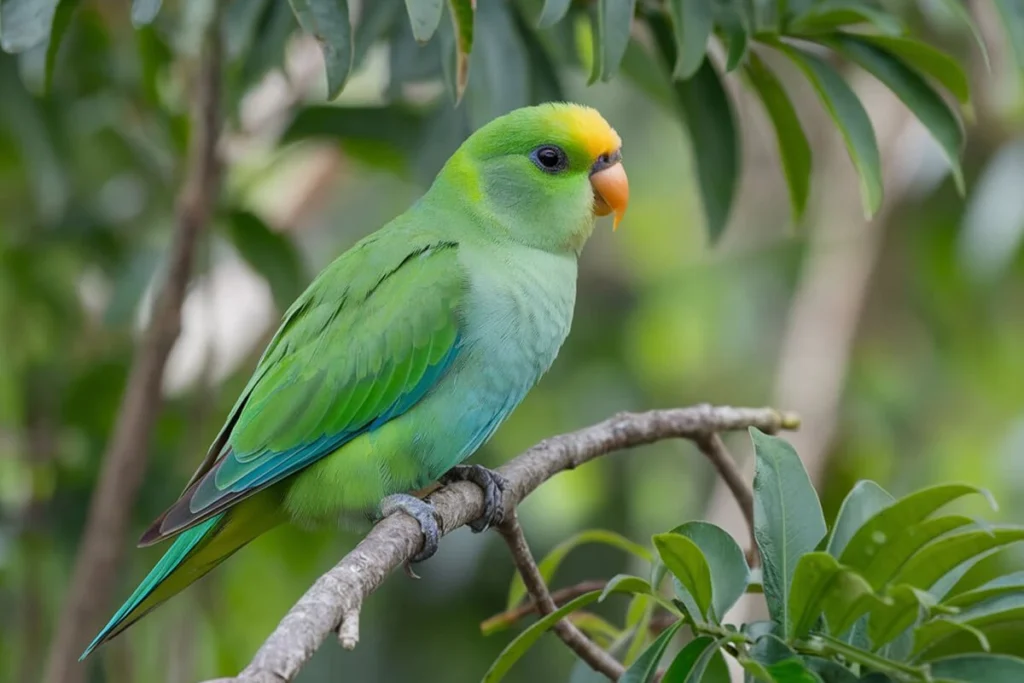
Playful and Affectionate Behavior That Wins Over Bird Enthusiasts
Bird lovers adore the Riparian Parrotlet because of its energetic, playful, and affectionate demeanor. This tiny parrot enjoys hopping from perch to perch, engaging with toys, and even mimicking simple sounds. It thrives on interaction, whether it’s playing with other parrotlets or forming a close bond with its human owner.
Unlike some birds that remain aloof, the Riparian Parrotlet actively seeks out companionship. It enjoys perching on a shoulder, nuzzling against fingers, and chirping softly to communicate. Its affectionate nature makes it a delightful pet, but it also requires social engagement to remain happy and healthy. When given the proper care and attention, this rare gem becomes a loving and lively addition to any bird enthusiast’s home.
Natural Habitat: Where This Rare Beauty Thrives
Native Range: Where the Riparian Parrotlet Calls Home
The Riparian Parrotlet thrives in the lush landscapes of South America, particularly in regions with abundant rivers and wetlands. As its name suggests, this rare parrotlet prefers riparian forests—ecosystems found along riverbanks that provide a rich variety of food sources and natural shelter. Countries like Brazil, Colombia, and Peru host populations of this tiny parrot, where it flits among dense vegetation, foraging for seeds, fruits, and small insects.
Unlike parrotlets that adapt to dry woodlands or open savannas, the Riparian Parrotlet depends on moist, tropical environments. The dense foliage offers protection from predators, while the proximity to rivers ensures a steady supply of water and food. These birds are often spotted in small flocks, chattering as they move between the trees, blending seamlessly with the vibrant greenery of their habitat.
Importance of Its Natural Environment for Survival
The riparian ecosystem is essential for the Riparian Parrotlet’s survival. These forests provide more than just food and shelter—they play a crucial role in regulating the climate, maintaining biodiversity, and sustaining countless other species. Without the dense tree canopies and rich plant life found along riverbanks, these small parrotlets would struggle to find suitable nesting sites and adequate nutrition.
Additionally, the seasonal flooding of riparian zones helps rejuvenate the environment, ensuring that the parrotlets always have fresh resources to rely on. Disrupting these delicate ecosystems can force the birds to relocate to less suitable areas, increasing stress and reducing their overall population. The health of riparian forests directly affects the stability of their population, making conservation efforts vital for their continued existence.
How Habitat Conservation Efforts Impact This Rare Bird Species
Deforestation, agriculture, and human development threaten the Riparian Parrotlet’s natural habitat. As trees are cleared for farmland or urban expansion, these birds lose the very resources they need to thrive. Additionally, pollution from industrial runoff and climate change-driven droughts can degrade riparian zones, making it harder for these ecosystems to support their native wildlife.
Conservation groups and environmental organizations have recognized the need to protect riparian forests to ensure the survival of species like the Riparian Parrotlet. Reforestation projects, legal protections for wetland areas, and responsible ecotourism efforts all contribute to safeguarding these birds’ natural environment. Supporting such conservation initiatives not only benefits the Riparian Parrotlet but also helps preserve the rich biodiversity of South America’s riverine habitats.
By understanding and protecting the Riparian Parrotlet’s native ecosystem, bird lovers and conservationists can ensure that future generations will continue to witness the beauty of this rare and charismatic species in the wild.
Diet and Nutrition: What Keeps the Riparian Parrotlet Healthy?
Natural Diet: Seeds, Fruits, and Small Insects
In the wild, the Riparian Parrotlet follows a diverse and nutrient-rich diet that ensures its health and energy. These small parrots forage among the dense vegetation of riparian forests and riverbanks, where they feast on a variety of seeds, fruits, and small insects. Seeds from native plants form a significant portion of their intake, providing essential fats and proteins to sustain their active lifestyle.
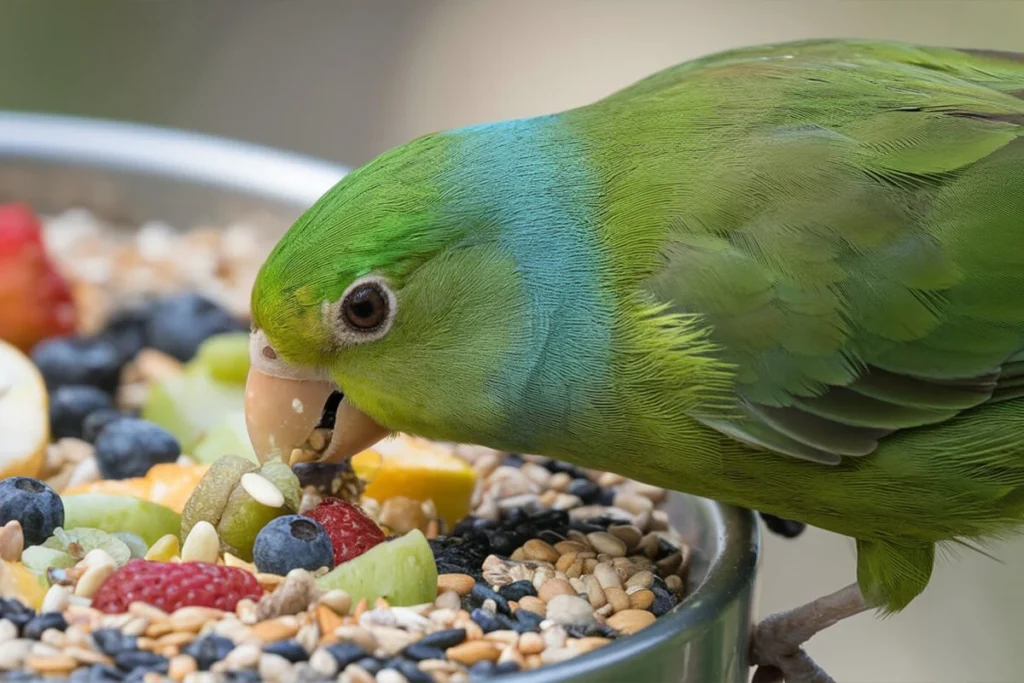
Fruits like berries, figs, and tropical fruits offer natural sugars, vitamins, and hydration, keeping these tiny birds both energized and well-nourished. Insects, such as small caterpillars and larvae, supply additional protein, which is especially important during breeding seasons when nutritional needs increase. The combination of these food sources ensures that the Riparian Parrotlet thrives in its natural habitat, maintaining its bright plumage, strong immune system, and playful energy.
Recommended Diet for Captive Parrotlets
When caring for a Riparian Parrotlet in captivity, mimicking its natural diet is essential to maintaining its health and well-being. A balanced diet should consist of:
- High-quality seed mix: Opt for a blend of small parrot seeds, including millet, sunflower seeds (in moderation), and canary grass seeds.
- Fresh fruits and vegetables: Offer a variety of fruits such as apples, bananas, mangoes, and berries, along with leafy greens like kale, spinach, and dandelion greens.
- Pellets: Formulated pellets provide essential vitamins and minerals that might be missing from a seed-based diet.
- Protein sources: Occasional servings of cooked eggs, mealworms, or other insect-based proteins can support overall health.
- Clean, fresh water: Always ensure the bird has access to fresh water, changed daily to prevent contamination.
A diverse diet keeps the Riparian Parrotlet engaged and prevents nutritional deficiencies that can lead to health issues such as weak feathers, poor digestion, and lethargy.
Common Feeding Mistakes to Avoid
Even well-intentioned bird owners can make mistakes when feeding a Riparian Parrotlet. Some common errors to avoid include:
- Overfeeding seeds: While seeds are a natural part of their diet, an excessive amount—especially high-fat seeds like sunflower—can lead to obesity and nutrient imbalances.
- Lack of variety: Relying solely on seeds without offering fruits, vegetables, and proteins can result in vitamin deficiencies, leading to poor feather quality and weak immunity.
- Feeding toxic foods: Certain foods are dangerous for birds, including avocado, chocolate, caffeine, onions, and high-sodium or sugary foods. Even small amounts can be toxic.
- Ignoring hydration: Fruits provide hydration, but fresh water should always be available. Dehydration can cause serious health issues.
- Not monitoring portion sizes: Overfeeding or underfeeding can both be harmful. Observing the bird’s eating habits helps ensure it gets the right amount of food without excess waste.
By understanding and implementing a nutritionally balanced diet, bird lovers can keep their Riparian Parrotlet healthy, happy, and full of energy, ensuring a long and vibrant life as a beloved companion.
Parrotlet Care Guide: Tips for Raising a Happy Companion
Ideal Cage Setup and Environment for a Pet Riparian Parrotlet
Creating the perfect environment for a Riparian Parrotlet starts with choosing the right cage. Despite its small size, this energetic bird needs plenty of space to move, climb, and play. A minimum cage size of 24 x 18 x 18 inches is recommended, but bigger is always better. The bars should be spaced no more than ½ inch apart to prevent the bird from getting stuck or escaping.
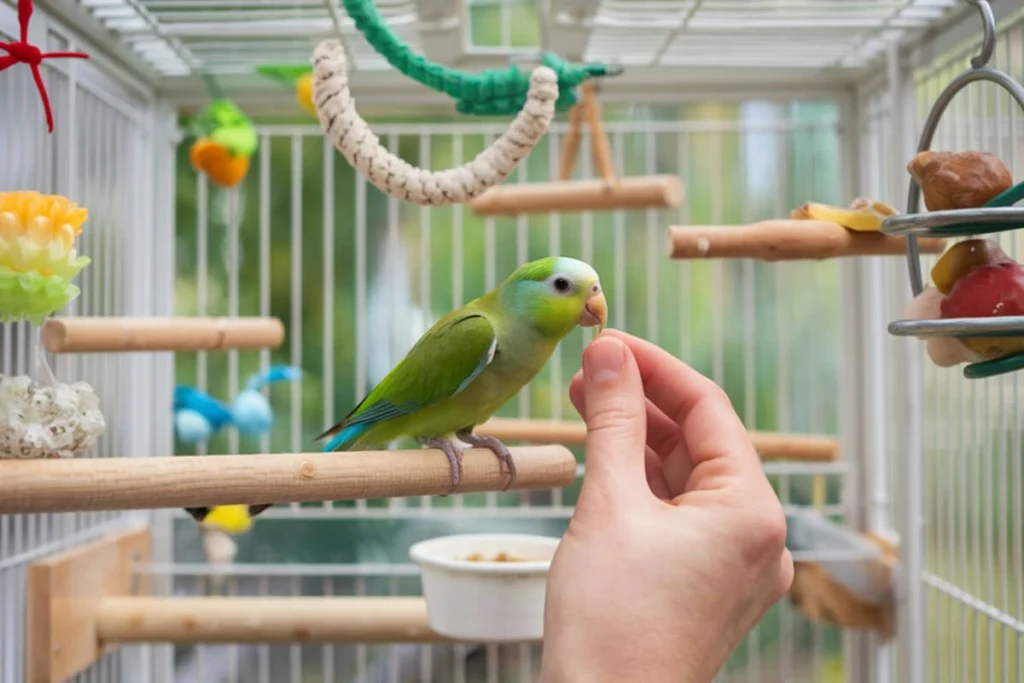
Inside the cage, provide:
- Multiple perches of different textures (natural wood, rope, and soft rubber) to promote foot health.
- Toys and enrichment items, such as hanging bells, ladders, swings, and shreddable toys, to keep it mentally stimulated.
- Food and water dishes positioned away from perches to prevent contamination.
- A cuttlebone or mineral block to help maintain beak health.
Place the cage in a quiet but social area—somewhere with natural light but away from direct sunlight, drafts, or loud noises. A stable daily routine helps keep the Riparian Parrotlet comfortable and stress-free in its environment.
Social Needs: Why Interaction and Playtime Are Essential
The Riparian Parrotlet is a highly social and intelligent bird that thrives on companionship. In the wild, it lives in small flocks, constantly interacting with its peers through chirps, play, and grooming behaviors. In captivity, it needs daily interaction with either a human caregiver or another bird to stay happy and mentally engaged.
To meet its social needs:
- Spend at least 1–2 hours daily interacting with your parrotlet. Talk to it, let it perch on your hand, and offer treats during training sessions.
- Provide plenty of toys to prevent boredom. Rotating toys regularly keeps things exciting.
- If possible, consider keeping a pair of Riparian Parrotlets to provide companionship, especially if you’re away for long hours.
- Allow safe out-of-cage time in a secure, bird-proofed room to encourage exploration and exercise.
Neglecting a parrotlet’s social needs can lead to stress, feather plucking, and even aggressive behavior, so regular engagement is essential for its well-being.
Health and Lifespan: Common Concerns and Veterinary Care
With proper care, the Riparian Parrotlet can live 10 to 15 years in captivity. However, maintaining its health requires a balanced diet, a clean environment, and regular veterinary check-ups.
Common health concerns include:
- Obesity – Often caused by a seed-heavy diet with insufficient exercise. Balanced nutrition and plenty of activity help prevent weight gain.
- Vitamin A deficiency – A lack of fresh fruits and vegetables can lead to respiratory issues and poor feather condition.
- Respiratory infections – Exposure to drafts, smoke, or poor air quality can lead to breathing problems.
- Beak and feather issues – Nutritional deficiencies or stress can result in brittle feathers and overgrown beaks.
- Parrotlet aggression – Without proper socialization, some Riparian Parrotlets may become territorial or nippy. Gentle handling and positive reinforcement training help prevent this.
Regular avian vet check-ups can catch health problems early, ensuring a long and happy life for your parrotlet. By providing a stimulating environment, proper nutrition, and daily socialization, you can keep your Riparian Parrotlet healthy, happy, and full of life for years to come.
Why Bird Lovers Adore the Riparian Parrotlet
Stunning Colors and Charming Personality
The Riparian Parrotlet may be small, but its beauty and personality make it stand out among exotic birds. Its bright green plumage, often accented with subtle hints of blue on its wings and tail, blends perfectly with the lush riparian forests it calls home. This vibrant coloration not only makes it visually stunning but also serves as natural camouflage in the dense vegetation of its native habitat.
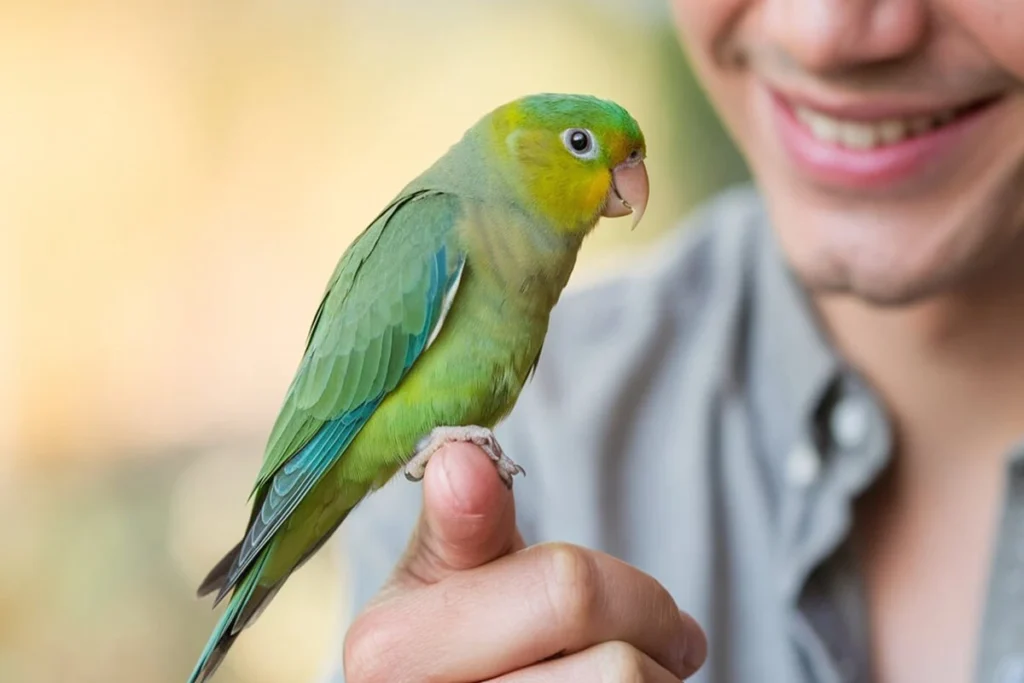
Beyond its striking appearance, this tiny parrotlet is bursting with personality. It is playful, curious, and highly intelligent, always eager to explore its surroundings and interact with its owner. Unlike larger parrots that require extensive training and handling, the Riparian Parrotlet easily bonds with its caregiver, making it an ideal companion for those looking for a small but lively pet. Its charming antics—hopping from perch to perch, playfully nibbling on toys, and chirping cheerfully—make it impossible not to fall in love with.
Its Status as a Rare and Exotic Pet Bird
Unlike common pet parrotlets, the Riparian Parrotlet is considered a rare and exotic species, making it a sought-after choice for dedicated bird enthusiasts. Due to its specific habitat requirements and limited distribution, this species is not as widely available as other small parrots, adding to its uniqueness. Bird lovers who are lucky enough to own one appreciate not only its beauty and intelligence but also the privilege of caring for a species that is still relatively unknown in the pet trade.
However, its rarity also means that responsible ownership is crucial. Ethical breeding programs and conservation efforts play an important role in ensuring that captive populations remain healthy and sustainable. For those interested in bringing a Riparian Parrotlet into their home, it’s important to seek out reputable breeders who prioritize the bird’s well-being over mass production.
The Joy of Owning a Small, Affectionate Avian Companion
Few birds match the Riparian Parrotlet’s combination of compact size, affectionate nature, and playful energy. Unlike larger parrots that require extensive space and maintenance, this tiny parrot offers all the charm of a larger bird in a small, easy-to-care-for package.
What makes this species truly special is its bonding ability. With proper socialization, it forms strong connections with its owner, often perching on their shoulder, chirping happily, and even nuzzling against their fingers. It thrives on companionship and interaction, making it an excellent pet for bird lovers who enjoy hands-on engagement with their avian friend.
Owning a Riparian Parrotlet is a rewarding experience filled with laughter, affection, and endless entertainment. Whether it’s learning new tricks, exploring its environment, or simply perching on your hand while chirping softly, this tiny parrot has a way of melting hearts and bringing joy to anyone lucky enough to share their life with it.
Conclusion
The Riparian Parrotlet is more than just a rare bird—it is a vibrant, affectionate, and intelligent companion that captivates bird lovers with its charm. Its stunning green plumage, playful nature, and social personality make it a standout among small parrot species. Whether thriving in the riparian forests of South America or bonding with a dedicated owner, this tiny parrotlet leaves a lasting impression.
Caring for a Riparian Parrotlet requires commitment, but the rewards are immeasurable. Providing a balanced diet of seeds, fruits, and small insects, setting up a stimulating and spacious environment, and meeting its strong social needs ensure a healthy and happy bird. Its affectionate behavior and lively energy make every interaction a joy, from playful chirps to gentle perching on a shoulder.
This rare and exotic species also highlights the importance of habitat conservation. Protecting the riparian forests and riverbanks where these birds thrive ensures their survival in the wild. Ethical breeding and responsible pet ownership help maintain their population in captivity while supporting conservation efforts.
For those seeking a small yet extraordinary bird, the Riparian Parrotlet offers an unbeatable combination of beauty, intelligence, and companionship. Whether as a first-time bird owner or an experienced avian enthusiast, welcoming a Riparian Parrotlet into your home means gaining a loyal and affectionate friend that brings endless joy. This rare gem truly melts hearts with its presence, making it a cherished companion for anyone who appreciates the wonders of the avian world.
Read About the Cobalt Parrotlet Secrets, Find the Best Training Tips In this Article.
Discover the Top 10 Small Parrots for New Owners Here.
Discover The Purple Parrot Birds From Here.
Read About Other Pets and breeds From HERE!
Find Out the Best stuff for your Pet On Pet MD Official.
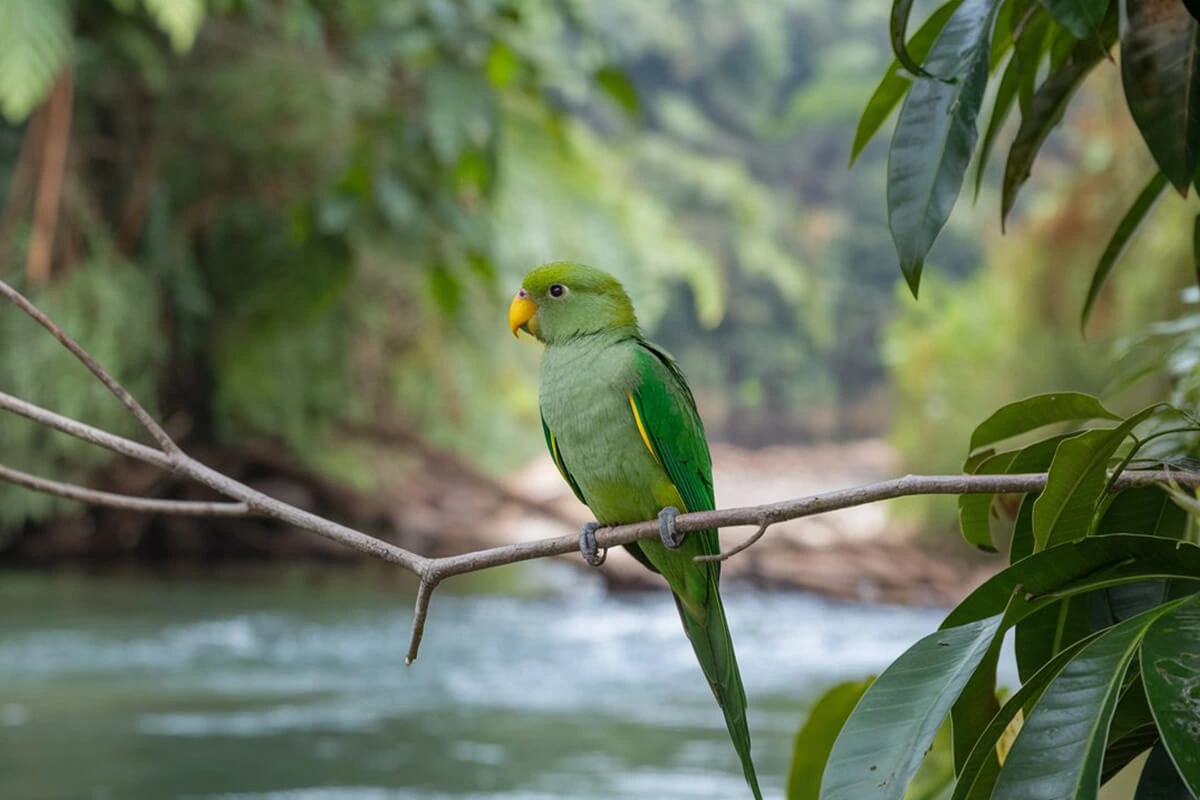
1 thought on “Riparian Parrotlet: Why This Rare Gem Will Melt Your Heart”
Comments are closed.